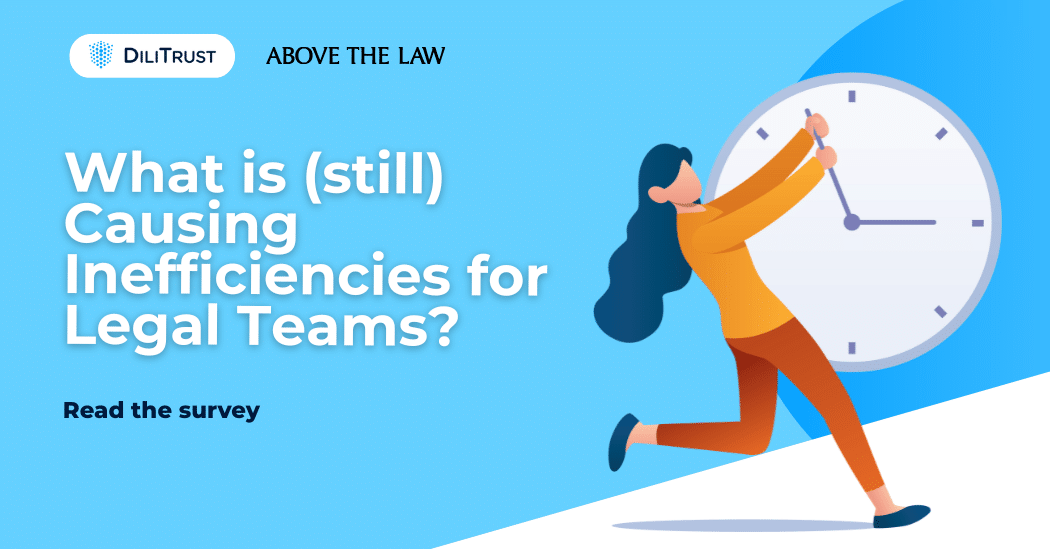In-house legal teams are still spending too much time on administrative work — and it’s taking a toll. Legal professionals have seen wave after wave of change—from leaner budgets to legal tech solutions promising to save the day. But how much has really changed? In our recent Q4 2024 survey, with our partner and Above the Law suggests: not much where it counts.
Even with all the new tools and roles in place, many legal teams are still overwhelmed by routine tasks. Admin work continues to eat up valuable time—time that could be spent on strategic thinking, business advising, and high-impact legal work.
What: A Day in the Life of a Legal Professional
Legal professionals may wear many hats—but how they actually spend their time tells a different story. The survey results reveal just how much of their day is absorbed by routine, non-legal work.
The key findings show:
That means nearly 9 out of 10 legal professionals aren’t focusing on the work that uses their expertise. There’s a clear mismatch between legal talent and how that talent is actually used. Without a doubt this leads to numerous internal challenges: whether on the moral side or in terms of inefficiency.
Why: Tasks and Manual Processes Holding Back Legal Teams
When thinking about legal teams and admin work, we mostly refer to redundant tasks that are time-consuming and often low in terms of impact. Let’s recap the key findings to understand why admin is still such a challenge.
The Most Time Consuming Tasks
The survey also looked into which tasks consume the most time. Several common pain points stood out, some may sound familiar…
Lawyers are expected to switch constantly between small urgent tasks and big-picture thinking. But without structure, it’s hard to focus. Over time, this kind of pressure wears people down. When legal professionals spend most of their day on low-value tasks, it’s no surprise they feel frustrated or disconnected from the impact they could be making.
The Real Consequences of Admin Burden
Legal employees, traditionally seen as risk managers and business advisors, often find themselves bogged down in everyday operational work. This shift doesn’t just affect individual satisfaction—it has real consequences for the broader organization.
Take, for example, a mid-sized tech company where legal staff spend hours every week manually updating contract trackers, responding to repetitive requests from Sales, or reviewing email threads for context. In one case, a legal counsel reported spending nearly two full days preparing a simple vendor contract approval—time that could have been used to guide the company through a major regulatory change.
This isn’t an isolated story. Legal teams across industries are spending far more time than they’d like on tasks that don’t require legal expertise. Things like formatting documents, searching for previous contract versions, or following up on approvals not only drain energy—they push strategic work to the margins.
As a result, legal departments may become disconnected from fast-moving business decisions. Morale dips when skilled professionals feel like their talents are wasted. And over time, the company risks treating Legal as a reactive service desk rather than a proactive business partner.
Impact on Legal Teams
The study surveyed legal professionals about the most frustrating tasks they encounter and how these impact their day-to-day operations. At DiliTrust, we found that not only is there a buildup of frustration due to inefficiency, but the top burdens also affect morale and the overall perception of legal teams within a company.
The key findings include that:
According to open-ended survey feedback, the most frustrating aspect of the job for 21% of professionals was administrative work. When asked what they’d prefer to focus on, legal research (27%) and strategic advising (23%) topped the list—indicating a strong desire to shift toward higher-value activities.
How: Tips to Regain Time for High-Impact Legal Work
Technology isn’t a miracle, meaning it’s not the sole solution of all problems for legal teams. Nevertheless, it’s a solid foundation to push teams to a more efficient and pleasing work environment. but it’s a solid foundation. Contract lifecycle management (CLM) and artificial intelligence-powered solutions for instance, deliver real-world value.
To better illustrate the benefits of LegalTech’s impact on day to day tasks, we compare manual workflows vs. automated workflows:
| Task | Manual Time | Automated with CLM & AI |
| Search for clauses | 1–3 hours | 1 minute |
| Review expiration dates | 1–3 hours | 5 minutes |
| Validate contract versions | Up to 1 day | 6 minutes |
| Overview of complex contracts | 2–3 days | 10 minutes |
| Creation to signature | Weeks | A few days |
By reclaiming even a portion of those hours, legal teams can reinvest their energy where it matters most. However, implementation must go beyond software.
Above all, the human factor must be considered—especially in the context of change management. After all, transformation starts with people. This means deliberately carving out time and space to explore inefficiencies, listen to frustrations, and build internal support for change. Before that, legal leaders should engage employees in defining what “better” looks like—and together with them, co-create the path forward.
Despite the use of document management systems and workflow tools, many departments still operate in silos. Workflows are hidden, tools don’t connect, and tracking is manual. But the root of the problem isn’t only technical. Legal teams don’t always have clear processes, shared priorities, or strong links to other departments. That leads to stress and confusion.
All the reasons above express the need to analyze your context and have some considerations for change.
Considerations for Change
Change must be supported by a clear, tailored communication strategy. Different decision-makers need different messages—some will care about operational efficiency, others about risk mitigation, and others about financial ROI. Making these advantages visible and accessible helps stakeholders recognize the full value of transformation. To embed change sustainably and improve team alignment, organizations should also consider:
Empowering employees with frameworks to confidently make decisions, rather than defaulting to excessive internal approvals can change everything. Legal departments should aim to enable people, not just automate tasks. Even the most powerful tech stack will fail if teams don’t know when or how to use it—or worse, don’t believe in it. Ultimately, reclaiming time and bringing people and processes together isn’t just about saving hours—it’s about restoring meaning to legal work and unlocking the full strategic value of in-house teams.
Building for the Future of Legal Work
Legal professionals aren’t asking for less responsibility—they’re asking for the chance to focus on what really matters. When legal work is dominated by emails, tracking files, and chasing approvals, the bigger picture gets lost.
But it doesn’t have to stay this way. With the right tools, clearer workflows, and better team alignment, legal departments can reclaim their time and rebuild their role as trusted advisors. It’s not just about working faster—it’s about working smarter, with more purpose and more impact.



